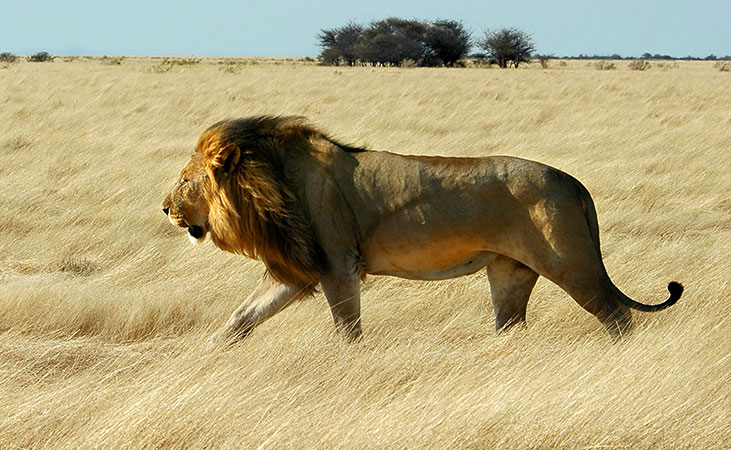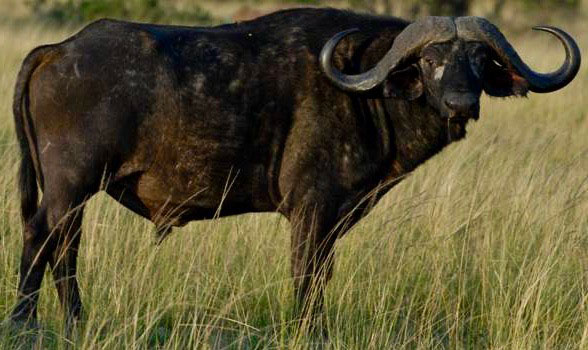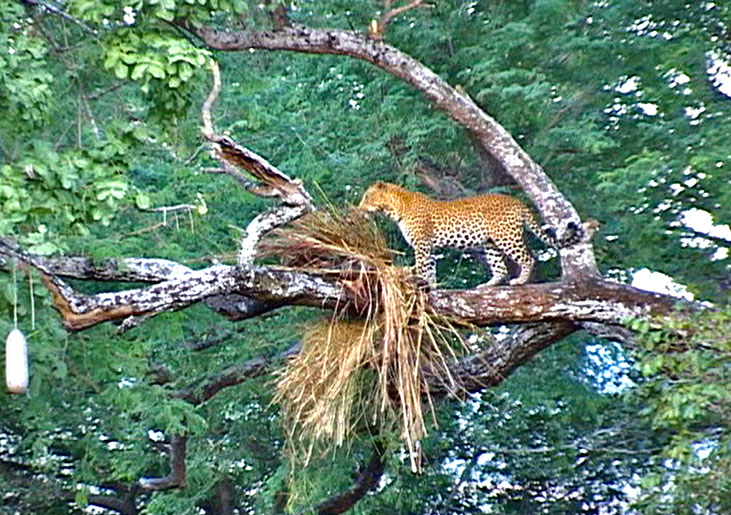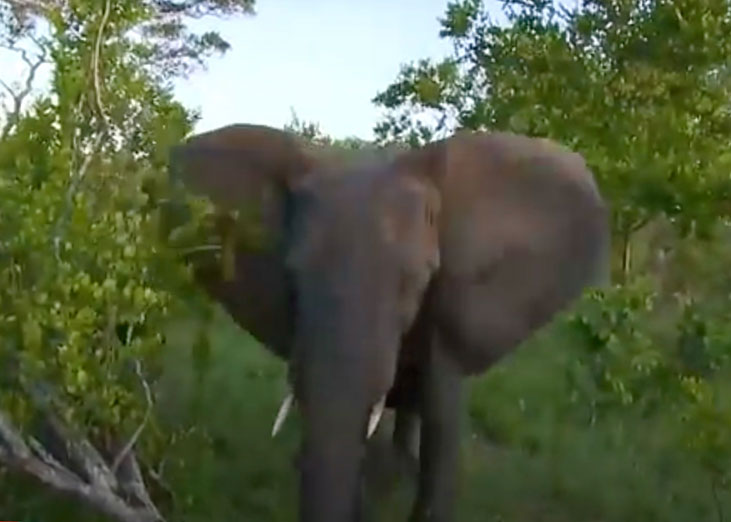MINIMIZING THE DANGERS OF AFRICA’S DANGEROUS SEVEN – Part 2
#4 LION
Unprovoked lion attacks on safari hunters are rare but they have happened. Sick or elderly lions who can’t hunt small antelope may turn to humans as a source of easy food. Random attacks can also occur in concessions where natural prey has been depleted, but for the most part, in normal conditions lions don’t usually target humans. So be smart as a hunter. Do your research to determine if lion prides are roaming in the block where you’re hunting. Factor all hazards, even if you’re just walking away briefly to take care of something in the bush.
Safari videos of horrendous lion charges have made their rounds on the Internet over the years. The PHs and clients, if they had a choice, would choose to go viral from anything other than this. It’s not really a badge of honor to be featured as such, so let’s just be straight up honest about one thing. Every one of these incidents is one hundred percent preventable and results from a poorly placed first shot. In most instances the bullet strikes the lion too far back toward the rear section of the body, missing the vitals. WARNING: Trouble will result when that happens.

So once again I stress, you the person with the gun or bow, are in control of eliminating that threat of danger. If you are going to hunt lion, do yourself the favor of properly preparing yourself for it. You may be shooting your rifle spot on with kudu and zebra, but with lion, it’s buck fever multiplied by 10. It all comes down to well-placed first shot—and the timing of your shot, that precise moment that you engage your trigger is crucial on a lion. For righties, if the lion is facing left, you get yourself in trouble if you yank the shot too far to the right. For southpaws, it’s exactly the opposite. There is some room for error but not a lot.
Furthermore, regarding your first shot, do not shoot a walking lion or one that has his vitals partially protected by bush. In the blind, on approach to the bait site or if stalking simba, you can perform mental exercises that distract your brain from the excitement of the moment, allowing you to focus on the reminders to make a perfect shot. Restrict caffeine intake if it’s a lion blind day, to minimize the jitters. Ask your PH to give you the green light in a warm voice, to shoot him. Not a frantic, “Take him! Take him!” This worked well for me on both lions. A polite order was given to take the shot and calmly I delivered.
NOTES FROM THE FIELD|TANZANIA & BOTWANA
No matter how great of a shot you think you are, that lion is not stone dead until you shoot him at least twice. Do not ever rush up to a lion you’ve dropped. The knee jerk reaction is to get as close as possible to become one with the moment. Instead, adjust your standing position to have a clear sight picture to watch as the cat expires. During this time give that animal some distance. Respect the worthiness of your opponent. Bullet chambered, safety off. Keep your eye on the prize. The lion can detect the vibrations from footsteps coming from the direction you’re approaching and if he has anything left, he’s gonna bring it to you one last time. The lion might give off a grunting or growling noise, warning you he’s not done yet if he senses you coming closer. When you hear that noise, take another finishing shot. There is no reason to be in a rush unless it’s getting dark. Even so, personal safety is the highest objective in this moment. This is a DG sequence in which the rules of engagement must be followed.
#3 CAPE BUFFALO
Next on the danger list is the Cape buffalo. It’s the most widely pursued of all the dangerous game and there are a handful of safety variables I want to point out off the top. 1) A non-fatally wounded Cape buffalo has an instinctive trait to go hide in the long grass and thick bush. It’s your responsibility to finish the job and this is where the heightened possibility of danger lies. Buffaloes charge to gore and trample you. However, when you administer a lethal first shot, the chances are greatly reduced, that the buff will be inclined to seek cover or muster enough strength to mount a charge. His aggression becomes limited as does his waning capacity to carry out his normal survival instincts. He’ll often meander, leaving a blood trail easy to follow and eventually fall dead, sometimes in an open area or next to a shrub he’s nestled alongside in hopes of bracing him from falling down. The herd, detecting he can no longer keep up, will eventually wander off, allowing you to recover your trophy. To fully comprehend the danger of hunting cape buffalo, I recommend reading, “Ecology and Behaviour of the African Buffalo: Social inequality and decision making,” by H.H.T. Prins. This study, along with what experienced hunters have written about the Cape buffalo, provided me a comprehensive education as to the capabilities and sheer toughness of this animal.

The easiest way to dispatch a Cape buffalo and isolate it from a herd is by delivering a fatal shoulder-heart shot. In safari videos, you’ll see and hear many proclamations from hunters about the armor-plated toughness of this animal. I believe from what I’ve witnessed first-hand that the plethora of these tales are told because the hunter HAS NOT struck the buffalo with a shot in the shoulder, penetrating the heart. Even a fairly well-placed lung shot can result in a minimum of three follow-up shots, sometimes allowing the buffalo to eventually make it to the thick stuff, daring you to come in and get him, before he expires. All of these scenarios explain why nyati is the most preferred African dangerous animal. Tough, intelligent and unpredictable, the deadly nature of Syncerus caffer can be reduced by having a thorough understanding of the formidability of this foe. This animal has my utmost respect, but I know his weaknesses, too. Exploit them and you’ll whip black death every time.
NOTES FROM THE FIELD|SOUTH AFRICA, MOZAMBIQUE, NAMIBIA, ZAMBIA, BOTSWANA, ZIMBABWE & TANZANIA
If your PH sprints after the buff following your first shot, that can often be a sign of a poorly placed first shot. Judging from the animal’s reaction, a PH can precisely determine where the bullet impacted. If the PH asks you, “How was your shot?” be honest. He wants to field judge you and your rifle capabilities. The more confidence he develops in you, the greater the likelihood of him allowing you to take more difficult, yet “safe” shots on dangerous game. This is how you mature as a dangerous game hunter.
A poorly placed shot with a bigger bore, .577, .500/.416, .470 or .416 is no match to a well-placed shot with a .375 or even a .338 on buffalo.
Sometimes a buff appearing 90 degrees broadside, (standing to the right) will actually be quartering away at 45 degrees. Don’t be fooled. I’ve seen right-handed shooters pull their shot in situations like this, missing the bull entirely. It’s a hunter’s natural tendency to simply shoot at a large area on the buff, because the kill zone is massive. Waterfowl hunters do the same thing when they flock shoot. This is wrong. Good clay shooters look for rings on top of the clay. To that point, every buff has indentations, muscle lines, scratches or hide imperfections. Look for marks like that to further assist you on precisely where to place the shot, based on what you know about the anatomy or your PH’s preference for shot placement. All of these tips can help in minimizing the danger while enhancing your safety. When a buff expires quickly, it’s not that the animal wasn’t tough. It means that you did your job well.
Finally, don’t ever leave the vehicle, short on ammunition. I made this mistake in Tanzania once. We saw a small buffalo herd two hundred yards off the road and I thought this was gonna be a quick one or two-shot kill with my .416 Rigby. Six shots later and a mile away from the landcruiser, I was out of bullets. The buffalo coaxed us right into the long grass. He even death bellowed but he wasn’t dead. When he charged, the PH saved me. Not a single one of those six shots I took hit him in the shoulder.
#2 LEOPARD
Most leopard shots range from 45-65 yards, with a trajectory slightly angled upward from a firm shooting rest, sometimes even a shooting sled. I will never question myself if, “I can make this shot.” My longest one has been 73 yards. But it is a shot that has caused me to wonder sometimes, “If I will miss.” Not to mention, they’ve all been taken at last light, adding a little extra touch to the danger. For that reason, the leopard comes in at number two even ahead of the Cape buffalo on my danger scale. Technically, it’s a chip shot. It is the easiest dangerous game shot hunters miss, sometimes completely, on a regular basis. What does that tell you? It means, there’s a whole lotta shaking going on. I’ve seen guys miss with $15K, ornately engraved “accurate” rifles. A reminder that these rifles, all souped up with these fancy, light sensitive push button scopes, do not shoot by themselves. There is such a thing called operator error. And it happens a lot when they’re staring down the tube at spotty. Let’s examine why.

For starters, the moment you look at the leopard through your scope, is most likely the first time you’ve ever seen him. The peep hole in the hide/blind you’re shooting from only gets opened when the PH makes the determination it’s time for you to ease your rifle into position to take the shot. Some PHs prefer also to pre-mount the gun in a shooting sled. “Spotted Fever” can hit you instantly. This malady is buck fever multiplied by 50. It can be unnerving and extremely difficult to keep the crosshairs from shaking.
The danger of this fever is that you have very little time to overcome it. At the most 2-3 minutes, and that’s on the generous side. And when it hits, it hits hard. Fatigue, inability to move, anxiety, awe of seeing the cat and pressure of missing, all contribute to the severity of this disease. Following a blood trail of a wounded leopard, in thick cover, with low light is every PH’s nightmare. A wounded spotty can see, hear, smell and be on top of you before you even see him. That’s why hunting the Prince of Darkness is so dangerous. That’s why seeing one in the daylight is so cherished. It’s the rarest sighting of any of the African dangerous game. Here’s your cheat sheet to not blow it.
- Shoot with your scope on low power for two reasons. Greater illumination and the wider the magnification, the less a scope will “shake.” Don’t make it harder on yourself than it already is.
- Pick out a specific rosette on the cat’s body that you want to shoot at, within your sight picture of what you’re seeing down the tube. This will also help you minimize the larger picture of what you’re looking at. A single rosette is not as intimidating as looking at the entire leopard.
- If you have the shakes, keep your shooting finger away from the trigger, even outside the trigger guard. This minimizes the possibility of an accidental firing.
- Your grip on the rifle should be firm, but not a “squeeze.” The vibrations from your body’s uneasiness will be transferred into more shaking of the rifle. A looser grip is often better.
- Visualize that perfect practice shot you made from the exact same distance that your PH made you take earlier in the day, prior to climbing inside the blind. You got this!
NOTES FROM THE FIELD: ZIMBABWE, ZAMBIA, TANZANIA
After you fire, be honest with the PH when he asks you about your shot, even if you think you made a poor shot. Unless it drops dead out of the tree, he has many decisions to make in a short amount of time. Calling in the rest of the crew, mobilizing the search party and all the necessary strategies to recover your leopard and keep you from getting scratched.
In Tanzania I shot a leopard with PH Gerard Miller in 2008. The cat was standing to the right and he bounded out of the tree as if it wasn’t even hit. Thin skinned and relatively soft boned, a bullet passes through the leopard in the blink of an eye. I told Gerard, “I hit him right behind the shoulder, dead on, no flinch.” With certainty I told him, “I did not pull the shot.” It got pitch black dark ten minutes later. After the rest of the tracker crew arrived, we got all geared-up to face the worst of danger. We found the cat stone dead after five steps of searching, behind the tree. Gerard told me afterwards that my remarks about my shot reassured him we’d find the cat dead. Based on my, “How was your shot?” response, Gerard made the determination the cat was dead. But still we took every precaution and patiently Gerard waited until certain the cat had expired.
If you see the cat’s reaction to your shot, that’s possibly not a good sign. In riflery terms, you violated follow through, not staying in your gun. If you pulled your eyesight from the scope tube above the gun to see the animal’s reaction to your shot, that movement could affect the accuracy of your shot placement.
#1 ELEPHANT
The largest living land mammal can be an intimidating sight. That also explains the draw of hunting them. Besides being massive, they’re loud, fast on their feet and they go rogue. The man versus elephant conflict results in the second most human fatalities (an estimated 400 per year) behind that of man versus hippo. But the elephant kills more hunters than hippos do. They have the ability to swat, gore, trample and disorient you. Many attacks are carried out by bull elephants in musth, a period of increased sexual activity. During this time an elephant’s testosterone levels increase dramatically. This is when male elephants are particularly prone to fight each other. They’ll often attempt to trample anything that comes too close. I found myself on the other end of this rampage once when I tried to take a snooze by a baobab tree in Tanzania. He was a rogue, solitary, old male who charged without provocation. It is also very unwise to get between a mother elephant and her calf. That’s a lot to be concerned with in search of big ivory, when the tuskers weigh as much as 13,000 pounds, standing 13 feet tall. But it gets even worse. Tuskless elephants, often smaller, are known to be even more aggressive. Add it all up and this is why elephant hunting is the most dangerous game in Africa.
Until you really learn what you’re looking at when you lay eyes on a herd, you might feel somewhat at a disadvantage. It’s a classic hunt I haven’t mastered, with still a long way to go. Hunting tuskless cows is even more dangerous and intense than hunting elephant bulls. Zimbabwe’s Zambezi Valley is home to some of the best of this hunting. The nasty mean old cows are pulled from the indigenous thick jess. And sometimes they find you before you find them. They have the speed, size and strength to flatten anything in their path when they determine you’re too close.

NOTES FROM THE FIELD|ZAMBIA, TANZANIA, ZIMBABWE & BOTSWANA You’ve likely seen video clips of PHs getting elephants to stand down by waving their guns and talking them back. WARNING: This is for the pros. Don’t try to duplicate this. If your PH yells run, turn the hell around and run. They’re experts in deciphering a mock charge versus a real charge. A PH knows the hazards of how hectic it can get instantaneously in the thick stuff and his first goal is to maintain your safety. Do your homework prior to embarking on this hunt, enabling you to field judge and identify quickly what type of elephant you’re looking at. For those seeking great risk and big rewards, this is the hunt for you. Even when you don’t take home tusks, your endurance and courage will be tested because you hunt elephants with your feet. You will find the trophy in the experience of the hunt.
Regardless of method of take, practice a lot in anticipation of this hunt, shooting at an upward angle. It’s one of the more difficult shots on dangerous game, especially factoring in fatigue on a long stalk with a double rifle. The shot will often be presented to you with little opportunity to get set on shooting sticks, in close quarters. In the best interests of travelling lightly, when setting out on a stalk some PHs don’t prefer shooting sticks, so familiarize yourself with shooting your rifle freehand at an upward angle. If you’re carrying a scoped rifle, keep it on low power, which gives you the largest depth of field in a snap second close shot.
Don’t make your DG pursuits any more dangerous than they have to be. Practice, research and be mentally aware of your field situation at all times. With more preparation you can take a little danger out of the term dangerous game–Bwana Moja
Editor’s Note: Bwana Moja is a lifetime SCI member who has been honored with numerous pinnacles of achievement over the years. He has produced eight safari films and written two books. His favorite two DG animals to hunt are buffalo and crocodile. He has numerous entries in the SCI record book, including two top-50 lions, a top 10 Giant Eland and a top 10 Mountain Nyala.

